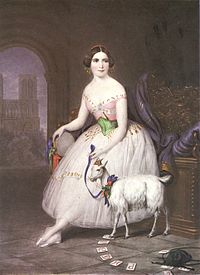Annotation:Esmeralda Polka (La)
X:1 T:Esmeralda Polka, La M:2/4 L:1/8 R:Polka B:Manson - Hamilton's Universal Tune Book vol. 2 (1846, p. 145) Z:AK/Fiddler's Companion K:C G|ee/f/ gc|e{e}d/^c/ d/e/f/g/|ad/e/ fB|c/c'/b/a/ g/a/g/f/| ee/f/ gc|e{e}d/^c/ d/e/f/g/|ad/e/ fB|c/c'/g/e/ c!Fin!|| G/c/|e e2e|ee{g}fe|eded|dcdc| e e2e|ee {g}fe|eded|ce/g/ c'!D.C.!|| d/e/|d b2 b/c'/|ba a/b/a|c a2 a/b/|ag g/a/g/| d b2 b/c'/|ba a/b/a|daba|agg!D.C.!||

The Esmeralda, sometimes called the Three-Slide Polka, was a ballroom dance popular in America in the second half of the 19th century. It consisted in a combination of steps from the polka and the galop. The music was usually a polka in 2/4 time; occasionally a 6/8 time tune was used.

